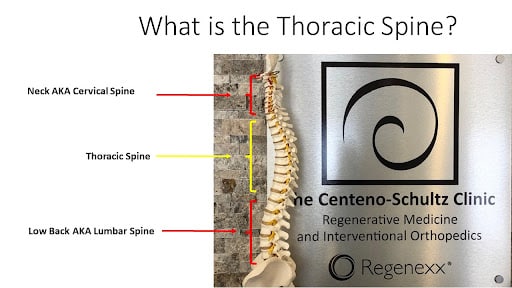Thoracic spine exercises are important for several reasons. First, they can help improve thoracic mobility, reducing the risk of spinal injuries and improving posture. Second, they can help to strengthen the muscles of the upper back and shoulders. Finally, thoracic spine exercises can help improve breathing mechanics.
What Is Thoracic Spine?
The thoracic spine, also known as the mid-back, is the section of the spinal column situated between the neck and the low back. It comprises 12 bony vertebral structures labeled T1-T12. Broadly referred to as the “T” section of the spine, the thoracic region forms a vital part of the skeletal framework.
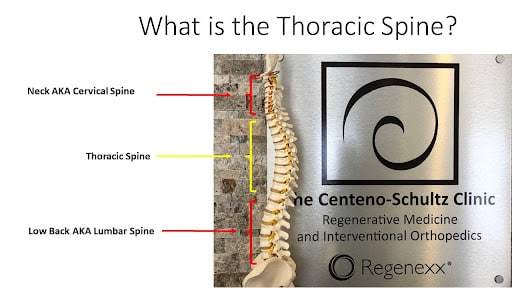
The thoracic spine plays a crucial role in protecting vital structures, maintaining an upright posture, and providing anchor points for muscles and ligaments. Below, we will delve into each of these functions and explore why they matter.
The thoracic spine has many important structures that can be injured causing significant pain and dysfunction. The major components of the thoracic spine include:
- Vertebrae Bodies: The bony building blocks that stack upon one another.
- Thoracic Discs: An important shock absorber that is sandwiched between each vertebral body
- Thoracic Spine Joints: Some are present throughout the vertebral column while others are uniquely in the thoracic.
There are 3 principal joints: thoracic facet joint, costotransverse joint, and costovertebral
- Thoracic Muscles: Superficial, intermediate, and deep back muscles.
- Thoracic Spine Ligaments: Thick pieces of connective tissue that connect bone to bone.
- Thoracic Spine Nerves: Nerves that run along the spine and connect to different areas of the body.
Importance Of Thoracic Spine Mobility
Thoracic mobility is important as it allows for proper spinal alignment thereby reducing the risk of cervical and lumbar spine injuries. It helps maintain good posture and neutral spine alignment which in turn reduces the strain on the neck and shoulders.
Thoracic mobility is also essential for proper breathing as the thoracic spine plays a key role in the expansion and contraction of the rib cage during respiration.
Causes of Thoracic Immobility
The are several different causes that can decrease thoracic mobility. The most common include:
- Sedentary Lifestyle: prolonged sitting, extensive screen time, and generalized lack of movement (1).
- Poor Posture: compromised posture such as slouching can decrease thoracic mobility.
- Aging: over time the thoracic discs become stiffer and less flexible which can decrease thoracic mobility.(2).
- Injury: trauma or injury to the thoracic spine can cause stiffness and immobility both of which can decrease thoracic mobility.
- Surgery: some thoracic spine surgeries such as thoracic fusion can limit the mobility of the thoracic spine (3).
Thoracic Spine Stretches
To improve your thoracic spine mobility, the most important thing you can do is stretch! The more the better. Thoracic spine stretches are a great way to improve thoracic mobility and range of motion. The benefits of thoracic spine stretches include improved posture, reduced risk of low back and neck injury, and improved flexibility. Common thoracic spine stretches include:
Seated Spinal Twist
Start in a seated position on the floor with both legs straight out in front of you. Take and place your left foot on the outside of your right knee. Take and place your right elbow on the outside of your left knee. Rotate your head, neck, and chest to the left and hold the posture for 1 minute. Relax and repeat on the other side.
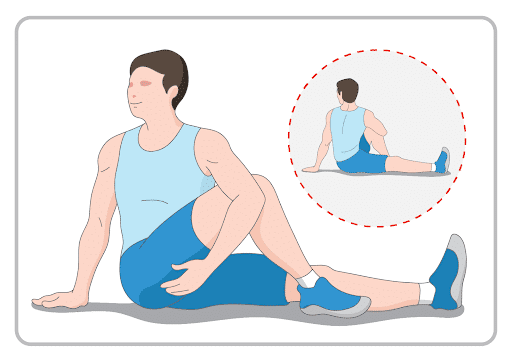
Thoracic Rotation Stretch
The thoracic rotation stretch is an easy and effective thoracic spine stretch. Sit tall in a chair with your shoulders down and back. Cross your arms with palms on the chest. Rotate to the right until you feel a stretch in the upper back. Hold for 1 minute and repeat on the other side.
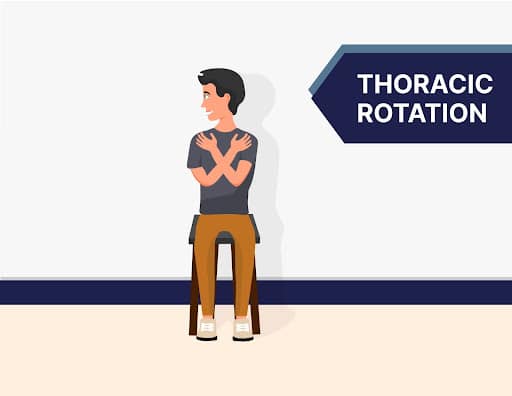
Thoracic Spine Strengthening Exercises
Thoracic spine strengthening exercises are an effective way of increasing the strength and endurance of the muscles that support the thoracic spine. They can also improve posture, spinal alignment and decrease the risk of cervical and lumbar spine injury. Two of the most common thoracic spine strengthening exercises are:
Resistance Band Rows
Resistance band rows are exercises that use resistance bands to strengthen the muscles of the upper back which include the rhomboids, trapezius, and latissimus dorsi. They can also help to bring the shoulder blades back and down. Resistance band rows can be performed in a variety of different positions that include standing, sitting, and kneeling.
Specifics:
- Secure the resistance band to a secure, stable anchor point
- Standing with feet shoulder-width apart, grasp the ends of the bands with both hands.
- Pull the shoulders down and back.
- Pull the band towards your body with elbows close to your body.
- Pause briefly when your hands reach your rib cage.
- Slowly release the band back to the starting position.
- Repeat.
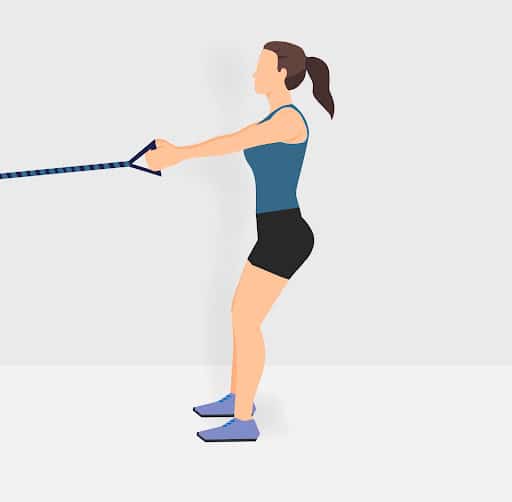
Prone T Extension
Prone thoracic extension exercises are exercises that involve laying your face down on your stomach on a flat surface and extending your thoracic spine. The exercises improve thoracic mobility, flexibility, and strength.
Specifics:
- Lie face down on a mat or flat surface with your hands by your sides or clasped behind your head.
- While keeping your legs on a flat surface and your core engaged, gently lift your upper body off the ground by extending your thoracic spine.
- Maintain neck in neutral spinal alignment
- Hold for 1-3 seconds and then slowly lower your upper body back down to the starting position.
- Repeat
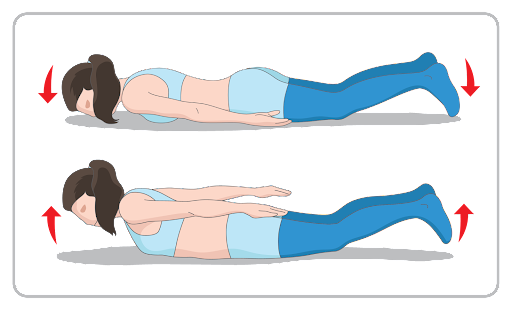
Postural Exercises For The Thoracic Spine
Postural exercises for the thoracic spine involve a range of movements and stretches designed to improve the alignment and mobility of the mid back. The purpose of these exercises is to help prevent or alleviate pain, stiffness and postural compromise that can result from prolonged periods of sitting or standing. The goal is to promote better thoracic spine function and health.
The two common postural exercises for the thoracic spine include:
Shoulder Blade Squeezes
Involves sitting or standing with good posture and gently squeezing shoulder blades together. To perform a shoulder blade squeeze assume a sitting or standing position with good posture and shoulders relaxed.
Then gently pull the shoulder blades together toward the spine, squeezing them together for several seconds and then release. This exercise helps strengthen muscles between the shoulder blades.
Wall Angels
Wall angels are a type of exercise that can boost posture and increase mobility of the thoracic spine. To begin, stand with your back to a wall- your feet should be hip-distance apart and arms outstretched at shoulder height with palms facing forward.
Next, lift your arms slowly above your head, maintaining back and arm contact with the wall as you move. Then, lower your arms gradually to the starting position.
Mobility Exercises For The Thoracic Spine
Mobility exercises of the thoracic spine are a series of exercises designed to target and improve the flexibility, range of motion, and overall mobility of the mid back. When incorporated on a regular basis they can alleviate stiffness, enhance posture and promote optimal spinal health. The most common thoracic spine mobility exercises are:
Thread The Needle
Starting position is on your hands and knees. Hands should be directly under your shoulders and knees under your hips. The left arm is then threaded underneath your body reaching towards the opposite side. Torso including the shoulders rotates to optimize stretch. The gaze is in the direction of the outreached arm. Hold position, release, and repeat on the other side.
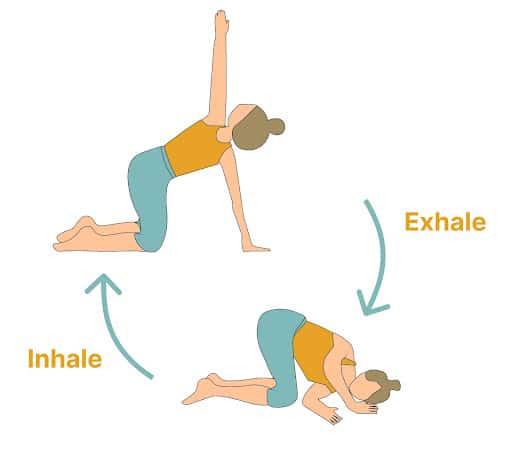
Thoracic Spine Rotation With Arm Sweep
A good exercise to enhance thoracic mobility and flexibility. Starting position is laying on your side. Legs are bent and may be on a foam roller or curled upon one another. Both arms are then outstretched in 90 degrees of flexion with one on top of the other. Much like when praying. The top arm is then swept overhead with rotation of the torso. The goal is to have the top arm outstretched and contacting the mat thereby opening up the thoracic spine.

Combination Exercises For The Thoracic Spine
Combination exercises for the thoracic spine are a series of movements that involve several muscle groups and joints to improve overall mobility and functional strength in the mid-back. These exercises generally consist of blended rotational, flexion, and extension movements designed to improve agility and resilience.
Squat With Overhead Reach
To execute the exercise, begin with your feet positioned slightly wider than hip-width apart. Slowly elevate your arms so that they align with your ears. While keeping your core engaged and back flat, lower yourself into a deep squat. Rise back up to a standing position and repeat the process.

Mountain Climbers With Bird Dog
Assume a plank position with your wrists under your shoulders and knees beneath your hips, all while keeping your back flat. Next, extend your right arm as well as your left leg out straight, striving to keep them parallel to the floor. Remember, a flat back is crucial.
Hold this position for a moment, and then return to the plank. Now, repeat the move on the other side.
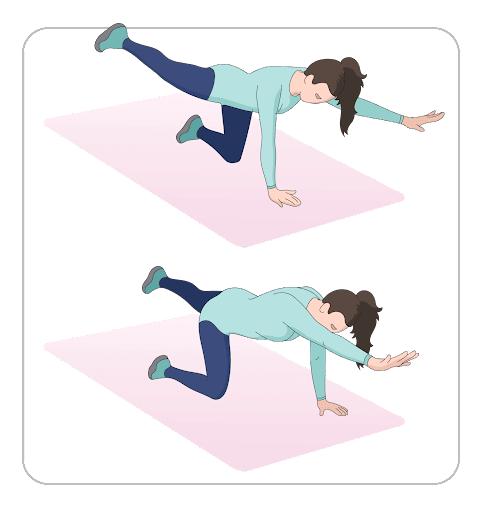
Precautions And Tips For Thoracic Spine Exercises
Maximize results and safety during thoracic spine exercises by following these essential guidelines and tips.
- Proper Warm-Up And Cool-Down
Proper warm-up and cool-down are crucial components of any exercise routine. They help prepare the body for physical activity and facilitate recovery post-workout. These practices can reduce the risk of injury, improve performance, and enhance overall fitness and wellness.
- Correct Technique
Adhering to proper form during exercise is crucial to prevent injuries and maximize the benefits of your workout. By doing so, you can effectively target the intended muscles and joints to achieve optimal results.
- Gradual Progression Of Exercise Intensity
By gradually progressing your exercise intensity, you can prevent injuries and overexertion. As your body strengthens and adapts, sustainable improvements follow.
- Use Of Proper Equipment And Form
Ensuring safety, minimizing the risk of injury, and optimizing workout effectiveness relies on both using proper equipment and maintaining correct form during exercises.
- Consultation With A Healthcare Professional
Thoracic spine exercises promote flexibility, strength, and stability. Thoracic pain can compromise one’s ability to perform these exercises. The Centeno-Schultz Clinic are expert in the evaluation and management of thoracic spine injuries.
Securing an accurate diagnosis is crucial as it will allow for the most effective treatment and outcome. Physicians are board-certified and fellowship-trained and can review past medical history, current medications and the onset of pain, and current radiographic studies to determine whether you are a candidate for regenerative treatments.
Options include PRP and bone marrow concentrate.
Practice Effective Exercises For Your Thoracic Spine’s Health
Thoracic spine exercises are important for several reasons. First, they can help improve thoracic mobility, reducing the risk of spinal injuries and improving posture. Second, they can help to strengthen the muscles of the upper back and shoulders. Finally, thoracic spine exercises can help improve breathing mechanics.
Thoracic spine exercises can improve thoracic mobility, enhance posture and strengthen mid and upper back muscles. The thoracic spine is that portion of the spine that is below the neck and above the low back. It is composed of multiple parts which include vertebral bodies, discs, joints, and nerves.
Mobility of the thoracic spine is important as it can reduce cervical and low back injuries, and improve posture and breathing. There are multiple causes of thoracic immobility which include a sedentary lifestyle, poor posture, aging and trauma.
The are multiple thoracic spine stretch and mobility exercises that improve thoracic spine function and overall health. Structural or degenerative conditions may cause thoracic spine pain which in many cases need to be addressed and managed prior to establishing a thoracic spine exercise program.
When rest fails to provide adequate relief the experts at the Centeno-Schultz Clinic can review non-surgical treatment options forgoing dependence on medications and unnecessary painful surgery.
Don’t let thoracic spine pain limit your daily activities. Schedule a consultation with us and start your journey to a healthier, pain-free life today.
- Lee, Y., Kim, K., & Lee, B. (2017). Association between sedentary behavior and spinal mobility in older adults. Journal of Physical Therapy Science, 29(8), 1316-1319. doi: 10.1589/jpts.29.1316.
- Benoist M. Natural history of the aging spine. Eur Spine J. 2003 Oct;12 Suppl 2(Suppl 2):S86-9. doi: 10.1007/s00586-003-0593-0. Epub 2003 Sep 5. PMID: 12961079; PMCID: PMC3591827.
- Anderson AL, McIff TE, Asher MA, Burton DC, Glattes RC. The effect of posterior thoracic spine anatomical structures on motion segment flexion stiffness. Spine (Phila Pa 1976). 2009 Mar 1;34(5):441-6. doi: 10.1097/BRS.0b013e318198c62d. PMID: 19247164.
